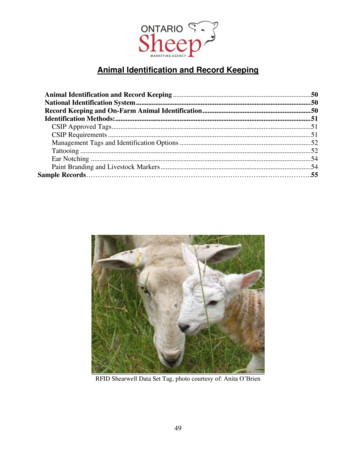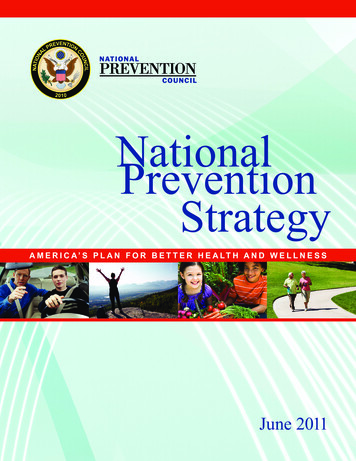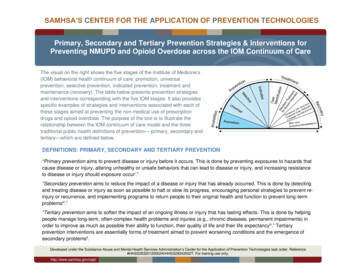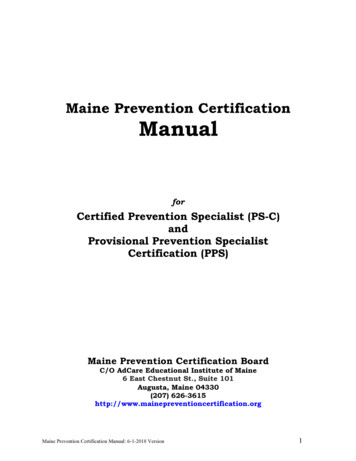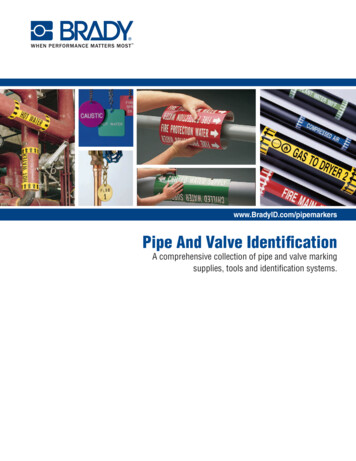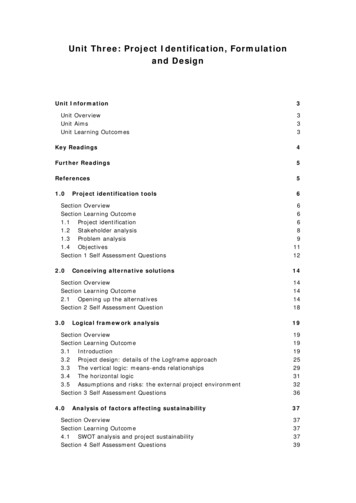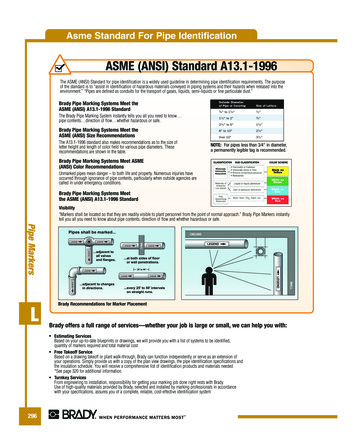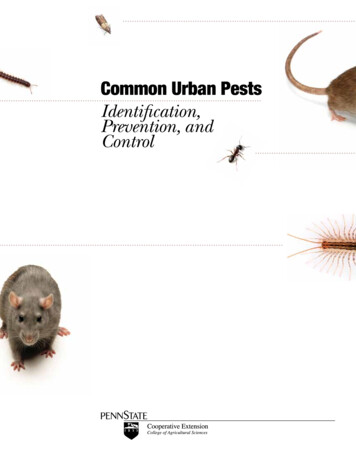
Transcription
Common Urban PestsIdentification,Prevention, andControl
Integrated pest management (IPM) is a safe, economical, and effective wayto control pest problems while protecting both human and environmentalhealth. IPM combines multiple tactics that are the most effective and leasttoxic while emphasizing preventative measures and alternatives to pesticides.If a pesticide is used, it should be the least hazardous and target only thepest causing the problem. Taking an IPM approach is more likely to be costeffective and result in long-term pest control compared to conventional pestmanagement practices. It is also less hazardous to human health.Pests enter homes and buildings looking for food, water, and shelter,and there is no “one-size-fits-all” solution that will solve all pest problems.Here are some basic preventative steps that can help stop a pest problembefore it starts:1.Eliminate food. Store food in hard, reusable containers with airtight,fitted lids; keep trash in a can with a tight-fitting lid and take it out ona regular basis; clean or vacuum up crumbs and spills when they occur;keep food in the refrigerator when possible.2.Eliminate water. Fix leaky and dripping pipes, faucets, and roofs; reducehumidity in basements and other moist areas of the home, such asbathrooms and kitchens; place metal screens in drains where feasible.3.Eliminate shelter. Get rid of clutter; seal cracks and crevices with siliconecaulking and copper mesh where appropriate; fix or replace brokenscreens; maintain yard and outside areas; remove trash; prune trees,shrubs, and groundcover so they are not touching the building.4.Talk with neighbors about pest management. Pests don’t stay in onelocation, so work together to minimize pest issues in the community.Before you can choose and use effective IPM tactics, you mustfirst know what pest you are dealing with. Proper identificationand management may require the assistance of a licensed pestmanagement professional. Remember, sometimes differentspecies require different tactics (e.g., the Norway rat versus theroof rat). After the pest is identified, other sources of informationcan be used to determine what tactics are best to use to manage it.An IPM toolkit is helpful to have available even if there isn’t currentlya pest problem. The toolkit contains basic items used when taking an IPMapproach to managing pests, such as a flashlight, silicone caulk and caulkgun, copper mesh, flyswatter, cockroach bait stations, mouse snap trap,sticky traps for crawling insects, and fly paper. These items can assist withidentifying the proper pest, finding out where and how the pest is getting in,and starting pest management.Following are brief descriptions of common urban pests. For each pestlisted there is a picture, a guide to its actual size, a general description of thepest, whether it’s a nuisance pest or a health concern, and some basic controlmeasures. This fact sheet is not all inclusive. Contact the Pennsylvania IPMProgram (www.paipm.org), the Penn State Department of Entomology (814865-1895), or your local Penn State Extension office (extension.psu.edu/counties) for more information.Approximate actual length is indicated byto the right of the photos.
Ant, CarpenterAnt, PavementBed BugCentipede, HouseSize: Colony has varying sizesof workers, ¼–½ inch (6–13millimeters, mm) in length.Size: Worker ants are all similar insize, 3 32 – 1 8 inch (2.5–3.0 mm) inlength.Size: Adult is 3 16 inch (5 mm) long.Size: Adult is 3–4 inches (8–10centimeters, cm) includingantennae and legs.About the pest: The carpenter antis a large, dark-colored, winglessworker ant commonly found instructural wood. It enters homeslooking for food and may chewextensive tunnels in moist orrotting wood. At certain times,winged forms may be seen in greatnumbers.About the pest: Pavement ants aresmall and vary in color from darkbrown to black. The worker ants arewingless and enter homes throughcracks in search of food. They willeat many types of foodstuffs, butsweet foods are especially attractive.Ants lay down a chemical trailthat other ants can use to findthe food source. The colonies liveoutside and can be recognized bythe sand piles visible in cracks ofconcrete, sidewalks, and at the topof foundation walls.Health concern or nuisance:Nuisance—they sometimes causestructural damage.Control measures: Prune backnearby trees, bushes, and foliagethat may be touching the home;store firewood well away from thehome; eliminate excess moistureand wet wood in the house; sealcracks, crevices, and openingsaround pipes with silicone caulk;if ants are foraging in the house,try various ant baits. For persistentor difficult infestations, contact alicensed, reputable pest controlcompany.Health concern or nuisance:Nuisance.Control measures: Store food insealed containers; keep thingsclean and dry; caulk cracks, repairscreens, and use door sweeps; don’tleave pet food out or nest the bowlin a larger dish of soapy water,creating a moat; squish visibleworker ants; use soapy water to wipeup the chemical trail; use ant baitsand remove them when the antsare gone.About the pest: Bed bugs arechestnut brown in color and haveflattened, oval bodies, whichswell and turn dark red after ablood meal. They hide during theday in tiny spaces around theirfeeding site, such as on mattresses,furniture, and in cracks andcrevices, and then feed on humansat night. Itchy welts may resultfrom the bed bug bite. Bed bugsdo not cause or spread disease, butthey are difficult to control oncethey have entered a building orhome. They can be transportedfrom one location to another inclothing, furniture, and luggage,and they can even walk from onearea to another through cracks andconduits for wiring and piping.They do not fly or jump, nor dothey live on people.Health concern or nuisance:Nuisance, but they do cause mentalanguish and stress.Control measures: Prevention isthe best control measure—avoidbringing in used furniture andmattresses; inspect baggage andclothing after traveling; toss suspectitems in the dryer and dry onhigh for 30 minutes; seal cracksand crevices; reduce clutter. Anestablished bed bug problem willrequire the assistance of a licensed,reputable pest control professional.Do not try to treat the homeyourself with aerosols and “bugbombs.” These products do notcontact the hidden insects and maydrive the bugs farther into hiding.About the pest: House centipedesare long, flat, and have 15 pairs oflong legs as an adult (one pair perbody segment). Their bodies area brownish-yellow color and havethree dark longitudinal stripes,while their legs are banded lightand dark. They prefer dark, damp,cool locations and hide during theday. House centipedes can comeinto the house via drains and sumppumps. They can run extremelyfast. They are predaceous and comeout at night to feed on silverfish,cockroaches, spiders, and othersmall arthropods.Health concern or nuisance:Nuisance.Control measures: Cover drainsand sump pumps with screening;remove shelter for centipedes,such as cardboard boxes; caulkand fill cracks and crevices; use adehumidifier to remove humidity;keep things clean and dry. A highpopulation of house centipedesmay indicate a large population ofprey species—monitor accordingly.
Cockroach, AmericanCockroach, German(Often called “water bugs”)Size: Adult is ½–5 8 inch (13–16mm) in length.Size: Adult is 1½ –2 inches (38–50mm) in length.About the pest: The reddish-brownAmerican cockroach is commonlyfound in the pantry, kitchen,bathroom, and basement. They areoval shaped with long antennae,feed on many different things,and prefer a moist, warm, darkarea. During the day they tend tohide in cracks and crevices nearfood sources. These roaches gluetheir egg cases to vertical surfaces.American cockoaches tend to enterhomes by crawling in from outsideor up sewers and drains. Theseroaches can fly as well as run.Health concern or nuisance:Health concern—they can carrydisease-causing bacteria and canalso trigger allergic and asthmaticreactions in some individuals.Control measures: Cover floordrains with screen and make surethere is water in all water traps;store food in sealed containers;keep things clean and dry; caulkcracks, repair screens, and usedoor sweeps; reduce clutter;inspect materials brought into thehome; use cockroach baits; usesticky traps to monitor for newinfestations; vacuum up largerinfestations of roaches. Boric acidor diatomaceous earth dust can bepuffed into wall voids for long-termcontrol.About the pest: The Germancockroach is commonly foundin the kitchen, bathroom, andpantry. They hide in cracks andcrevices during the day. This is themost common cockroach foundin homes and apartments. Theyare light brown or tan in color andhave two dark strips running fromthe head to the wings. They preferthe environment to be warm andmoist and will eat a large varietyof foods. These cockroaches carrytheir egg cases around with them,protruding from their abdomensuntil right before the eggs hatch.Cockroaches can hitchhike fromanother location to your home initems such as bags and boxes.Health concern or nuisance:Health concern—they can carrydisease-causing bacteria and canalso trigger allergic and asthmaticreactions in some individuals.Control measures: Store food insealed containers; keep thingsclean and dry; caulk cracks; reduceclutter; inspect materials broughtinto the home; use cockroach baitsand gels; use sticky traps to monitorfor new infestations; vacuum uplarger infestations of roaches. Boricacid or diatomaceous earth dustcan be puffed into wall voids forlong-term control.Cockroach, OrientalFlea(Sometimes called “water bugs”)Size: 3 16–1 8 inch (1.5–3.0 mm).Size: Adult is 1¼ inch (32 mm) inlength.About the pest: Orientalcockroaches are very dark brownor almost black in color with agreasy-looking sheen to theirbodies. These cockroaches prefercool, dark, damp places at orbelow ground level, such as sewers,drains, crawl spaces, garbage cans,dumps, and trash chutes. They arenot generally found crawling upwalls, nor are they usually foundin cupboards or on higher floorsof buildings. They eat decayingorganic matter both inside andoutside the home.Health concern or nuisance:Health concern—they can carrydisease-causing bacteria and canalso trigger allergic and asthmaticreactions in some individuals.Control measures: Checkbasements for sewage and drainproblems; keep drains coveredand basement windows and doorstight; keep areas clean and dry;caulk cracks, repair screens, andreduce clutter; store food insealed containers. If necessary, usecockroach baits. Use sticky traps tomonitor for new infestations. Boricacid or diatomaceous earth dustcan be puffed into wall voids forlong-term control.About the pest: Adult fleas aresmall, flattened, dark-coloredinsects with legs adapted forjumping. They do not fly. Adultsspend most of their time on ananimal’s body. Fleas lay eggsthat fall off the host animal anddevelop into larvae. Flea larvae,which are tiny, white, and wormlikein appearance, can live in rugs,cracks, and crevices in the floorand anywhere a pet may sleep,including outdoors during warmerweather.Health concern or nuisance: Healthconcern—bites cause irritationand fleas may cause serious allergysymptoms in some animals andhumans.Control measures: Indoors, coverpets' sleeping areas/beds withsomething you can wash regularly;comb pets with flea comb; bathepets regularly; vacuum floors,carpets, and furniture often; useborate-based carpet treatments thatcontain an insect growth regulator.If there are high flea populationsoutside, use beneficial nematodes.Discuss flea-prevention options forpets with your vet.
Fly, FruitFly, HouseHead LiceMillipedeSize: Adult is 1 8 inch (3 mm) inlength.Size: Adult is 1 8–¼ inch (3–6 mm)in length.Size: Adult is size of a sesame seed;egg is size of a pinhead.Size: Adult: 1– 1½ inch (25–38mm).About the pest: Fruit flies areyellowish brown to dark brown incolor and usually have red eyes.They are especially attracted toripened fruits and vegetablesbut can also be found in drains,garbage disposals, trash containers,and anywhere else that is moist andhas fermenting material. They laytheir eggs in these materials anddevelop very quickly from larvaeto adult.About the pest: House flies havefour dark stripes on the top oftheir middle body region. Whena house fly lands on solid food, itregurgitates saliva on the food toliquefy it before ingesting it withits sponging mouthparts. They willfeed on whatever food sources theyfind themselves on, including fecalmatter and other moist, decayingmatter.About the pest: Head lice are tinyinsects that spend their entire lifeon the human scalp. They feedon blood. Eggs (sometimes callednits) are found glued at the base ofthe hair shaft. Once hatched, licenymphs and adults can walk andmove around the scalp and hair aswell as from one head to anotherif the two heads come in contact.Head lice cannot jump or fly butare transferred between peopleby brushes, comb, hats, or otherheadwear.About the pest: Millipedes,sometimes called “thousandleggers,” have two pairs of legsper body segment and are oftendark brown in color. They havea hard outer skin and prefer tolive in cool, damp places outside,such as compost or grass clippingpiles, under stones and bricks, andin mulch. They are slow-movingcreatures that eat decaying plantmaterial and cannot bite peopleor cause damage to homes. Theymay accidentally enter basements,homes, and garages when plantmaterial accumulates by doors andwindows or during heavy rain ordrought conditions. They only livea few days indoors.Health concern or nuisance:Nuisance, although they canpotentially contaminate food withbacteria.Control measures: Eliminatesources of attraction; eat,refrigerate, or discard ripenedproduce; keep things clean and dry;have tight-fitting screens in windowsand doors; catch flies in a trap byplacing a paper funnel in a jar thathas a few ounces of cider vinegar inthe bottom. Clean traps weekly andreplace with fresh vinegar.Health concern or nuisance:Nuisance, although there’s a highprobability they transmit numerousdiseases to humans.Control measures: Seal or plugcracks and gaps around windows,doors, and any pipes entering thebuilding; repair holes in screensand make sure they fit the windowtightly; keep things clean and dry;remove trash and garbage; keepgarbage outside in a tightly sealedcontainer; use a flyswatter; usesticky fly traps or tape.Health concern or nuisance:Nuisance—they do not pose ahealth risk but are irritating to thescalp.Control measures: Use a metallice comb specifically designed toremove the lice and eggs; place thecomb containing lice and eggs insoapy water and flush this waterdown the toilet when finished withcombing; boil a metal comb inwater for 15 minutes before usingon another person. Recheck headsevery 3 days for newly hatched lice.Launder all bedding and clothingfrequently in hot, soapy waterand dry on hottest setting whiletreatment for lice is occurring inthe home; place nonwashable itemsin tightly sealed plastic bag for twoweeks or have them dry cleaned;vacuum carpets, car seats, andfurniture.Health concern or nuisance:Nuisance.Control measures: Keep doorsweeps and window seals ingood repair; remove leaves andother debris from around doors,stairwells, and windows; sweep orvacuum up millipedes found in thehome.
5– 8" including tailAdult (top); larvae in water (bottom)MosquitoMoth, Indian MealMoth, Webbing ClothesMouse, HouseSize: Varies up to ½ inch (13 mm).Size: Moth is ½ inch (13 mm) inlength; fully grown larva is ½–5 8inch (13–16 mm) in length.Size: Moth is ¼ inch (6 mm) inlength; mature larva is ½ inch (13mm) in length.Size: 5–8 inches (13–20 cm) inlength (including tail).About the pest: The Indian mealmoth is most commonly seenflying around in kitchens at night.It has reddish-brown markingswith a copper luster on the lowertwo-thirds of its wings. Larvae areyellowish, greenish, or pinkish witha brown head capsule and threepairs of legs near the head. Thelarvae are found in common pantryitems like cereal, flour, grains andgrain products, and dried fruit andnuts. Larvae leave behind visiblewebbing as they crawl around andpupate in these products.About the pest: The webbingclothes moths have tufts of red hairson their head and golden-coloredwings. The larvae have white orcream-colored bodies and a brownhead. These moths feed on animalby-products like furs, hair, feathers,and wool carpets and clothes. Theyprefer dark environments and theadult moths will tend to run insteadof fly when disturbed.About the pest: Mosquitoes aresmall biting flies with long legs.Females require a blood meal andlay their eggs in standing water.Eggs hatch into larvae, sometimescalled "wigglers," that can be foundand easily seen in water. Adultfemale mosquito bites cause itchy,raised, red bumps.Health concern or nuisance:Both— they can transmit diseasefrom one organism to anotherwhen biting; some mosquitoes aresources of diseases such as WestNile Virus (WNV).Control measures: Eliminatestanding water outside. Payparticular attention to temporarypools of water near the home suchas in gutters, birdbaths, rain barrels,tires, plant pots, buckets, and lawnfurniture. The mosquito speciesthat transmits WNV uses theseplaces to lay their eggs. For smallponds that cannot be emptied atleast once a week, consider usingproducts that contain the biologicalcontrol called “Bti” to kill mosquitolarvae. In addition, limit outdooractivities at dusk and dawn, whenmosquitoes are most active orwear long pants and long-sleeveshirts to minimize exposed skin;close doors and windows; repairholes in screens and gaps arounddoors. If repellents are to be usedon children, they should mostsafely be applied to clothes notskin, especially faces and hands.Avoid products with more than 10percent DEET.Health concern or nuisance:Nuisance.Control measures: Inspect newlypurchased grains before puttingthem in the pantry; store food intightly sealed containers; if mothsare sighted, search all dried food(e.g., cereal, pet food, oats, andother grains) and dispose of anyinfested food products; vacuum andthoroughly clean shelves to removeboth insects and spilled food; usea flyswatter to kill adult moths.Pheromone traps containing a lureto attract male moths can be usefulin detecting a problem early butwill not provide control.Health concern or nuisance:Nuisance.Control measures: Launder ordry clean infested materials; hanginfested rugs outside and beat orbrush them; keep areas clean andwell vacuumed; vacuum up theclothes moths.About the pest: House mice aresmall rodents with a pointed nose,large ears, and a long, hairless tailabout the same length as the bodyand head. They are active at night.A sign that mice are in the houseare dark droppings that are pointedand about the size of a grain of rice.Mice can enter the home throughvery small holes about the size ofa pencil. Mice look for food andnesting material in pantries andstorage boxes, and they’ll evenchew on electrical wiring. Thisbehavior can result in structuraldamage and possible fires.Health concern or nuisance: Healthconcern—they can spread diseaseand trigger asthma attacks in someindividuals.Control measures: Seal or pluggaps around windows, doors, thefoundation, and pipes to keep micefrom entering the building; usedoor sweeps under doors leading tothe outside; keep things clean anddry; reduce clutter; store food insealed containers; remove trash andgarbage; keep garbage outside in atightly sealed container; set mousesnap traps and check daily (be sureto put the “snap” side of the trapup against the walls where micetend to run; avoid using mousepoison pellets or chunks as they aredangerous for children and pets;plus, mice die behind walls andstink).
Rat, NorwaySilverfishStink Bug, Brown MarmoratedTermiteSize: 13–18 inches (33–46 cm) inlength (including tail).Size: Adult is ¼–½ inch (6–13 mm)in length.Size: Adult is ½ inch (13 mm) inlength.Size: Adult is ¼ inch (6 mm).About the pest: Norway rats are largerthan mice with a blunt nose and tailshorter than the length of its body.Their droppings are dark, blunt, andthe size of a raisin. Rats climb, jump,and gnaw and can enter the homethrough holes the size of a quarter.They can also swim through sewersand enter a building through toiletsor broken drains. Rats tend to liveoutside in underground burrows butmay enter the home in search of foodand nesting material. They will eat awide variety of food products and cancause structural damage. They canchew through almost anything. Ratsare most active at night.About the pest: Silverfish havesilver, carrot-shaped bodies that arethicker at the head and taperedat the abdomen. They have longantennae and three long filamentscoming from their abdomen.Silverfish prefer cool, moist, darkplaces like basements, closets,bookcases, and storage areas. Theymove very quickly when disturbed.Silverfish eat any substancescontaining starch, such as flour,cereal, books, wallpaper, and glue,but they will also feed on items highin protein.About the pest: The brownmarmorated stink bug has a brown,shield-shaped body, is almost aswide as it is long, and has lightbrown bands on the antennae.They release an odor as a defense.These are agricultural pests; theydo not harm humans, nor do theyreproduce or cause damage to thehome or anything inside it.Health concern or nuisance: Healthconcern—they can spread diseaseand may bite.Control measures: Remove foodsources or keep in tightly sealedcontainer; keep things cleanand dry; reduce clutter; usedehumidifier to remove humidity;seal cracks and crevices; repair leakypipes and roof; use sticky traps.Control measures: Seal gaps aroundthe building foundation and anypipes or wiring to keep rats fromentering the building; types of materials to use will depend on the situationbut include sheet metal flashing,cement, and/or heavy-gauge wiremesh; use metal flashing on tightfitting doors leading to the outside;keep things clean and dry; reduceclutter in and around building; storefood in sealed containers; removetrash and garbage; keep garbageoutside in a tightly sealed container.Indoors, set snap traps designed forrats and check daily; use and placethese traps with caution as the snapcan hurt children or pets. Do notuse rat poisons indoors. If usingsuch products outside, be sure to use“chunk” style baits in tamper-resistantboxes with bait holders. Follow alldirections on the baits.Health concern or nuisance:Nuisance.Health concern or nuisance:Nuisance—they can be smellywhen squashed or vacuumed up;sometimes large numbers will entera house in early fall looking for aplace to spend the winter.Control measures: Seal cracks,crevices, and openings aroundwindows, doors, pipes andchimneys; install a chimney flue capwith ½-inch or less hardware cloth;repair damaged screens on doorsand windows; remove insects frominside with a vacuum cleaner.About the pest: Termites are socialinsects that feed on old roots,tree stumps, structural wood,wood fixtures, and paper. Theyare found in basement or cellarareas and in structural wood abovebasement walls. Wooden itemsburied or in contact with theground are particularly susceptibleto termite infestation. The black,winged reproductive termites aremost commonly seen in infestedbuildings, especially betweenFebruary and June when theyswarm. If a piece of infested woodis opened, creamy-white workertermites may be seen. Termitedamage looks like runways orpassages cut into the wood. Termitetubes connecting abovegroundnests with the soil may also bepresent.Health concern or nuisance:Nuisance—they can causestructural damage.Control measures: Remove woodendebris from outside and aroundthe home; replace infested woodenmaterial; have adequate drainagein basements; do not bury scrapwood in the yard; keep fire woodpiles away from the house; sealcracks and crevices in foundation;direct all surface water away fromfoundation. Once a home isinfested, control requires the use ofa licensed, reputable pest controlprofessional.
Prepared by Amber Brunskill,education specialist; Kristie AumanBauer, public relations coordinator;Lyn Garling, manager of programs;Steve Jacobs, senior extensionassociate and urban entomologist;Dion Lerman, environmentalhealth program specialist; MichelleNiedermeier, community IPM andPSCIP coordinator; and Ed Rajotte,Penn State IPM coordinatorPhoto creditsCenters for Disease Control: Headlouse (p. 5)iStock: Carpenter ant, bed bug, andcentipede (p. 3), millipede (p. 5),Indian meal moth (p. 6), Norway rat,silverfish, and termite (p. 7)Wikipedia: House mouse (p. 6)Remaining photos provided by authorsPenn State College of AgriculturalSciences research and extensionprograms are funded in partby Pennsylvania counties, theCommonwealth of Pennsylvania, andthe U.S. Department of Agriculture.Visit Penn State Extension on the web:extension.psu.eduThis publication is available from thePublications Distribution Center, ThePennsylvania State University, 112Agricultural Administration Building,University Park, PA 16802. Forinformation telephone 814-865-6713.This publication is available inalternative media on request.The Pennsylvania State Universityis committed to the policy that allpersons shall have equal access toprograms, facilities, admission, andemployment without regard to personalcharacteristics not related to ability,performance, or qualifications asdetermined by University policy or bystate or federal authorities. It is thepolicy of the University to maintainan academic and work environmentfree of discrimination, includingharassment. The Pennsylvania StateUniversity prohibits discriminationand harassment against any personbecause of age, ancestry, color,disability or handicap, national origin,race, religious creed, sex, sexualorientation, gender identity, or veteranstatus. Discrimination or harassmentagainst faculty, staff, or students willnot be tolerated at The PennsylvaniaState University. Direct all inquiriesregarding the nondiscrimination policyto the Affirmative Action Director,The Pennsylvania State University, 328Boucke Building, University Park, PA16802-5901; Tel 814-865-4700/V, 814863-1150/TTY.Produced by Ag Communications andMarketing The Pennsylvania State University2011Code# EE000710M8/11CT5094
identifying the proper pest, finding out where and how the pest is getting in, and starting pest management. Following are brief descriptions of common urban pests. For each pest listed there is a picture, a guide to its actual size, a general description of the pest, whether it's a nuisance pest or a health concern, and some basic control

